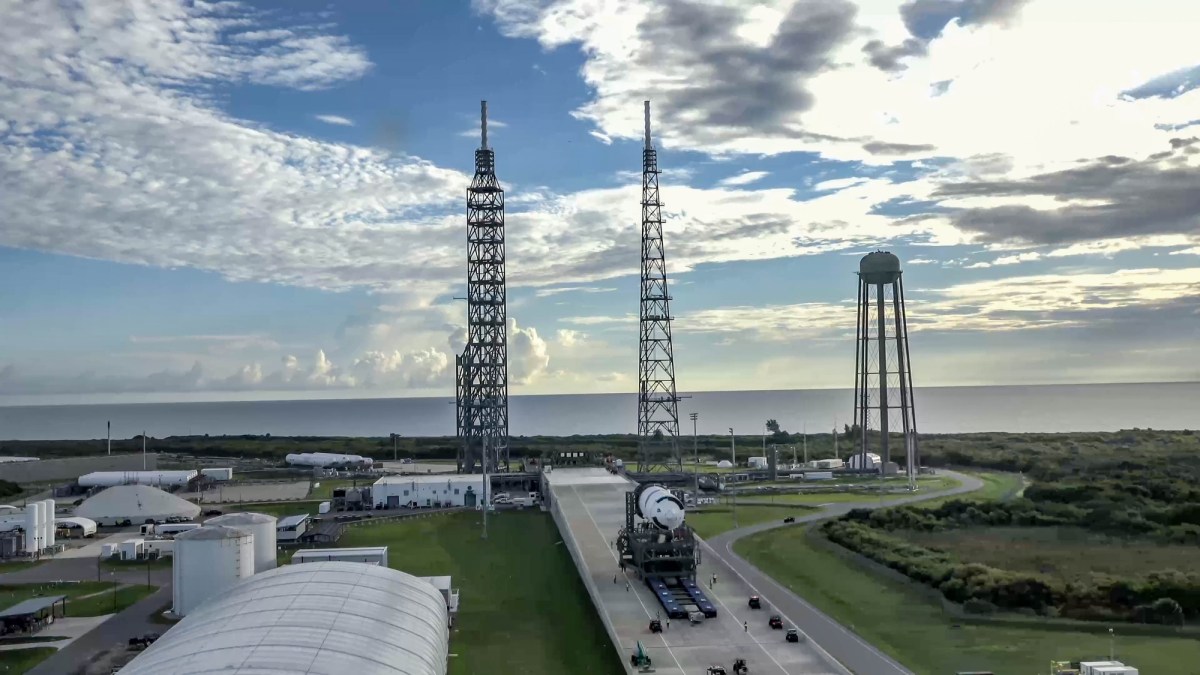WASHINGTON — While preparations for the first launch of Blue Origin’s New Glenn rocket are accelerating, the company acknowledges there is “lots to do” to get the vehicle ready to meet a narrow launch window next month.
The company has highlighted several major milestones towards the inaugural launch of the vehicle from Launch Complex 36 at Cape Canaveral Space Force Station in Florida, currently scheduled for no earlier than Oct. 13. That included the arrival Sept. 4 of Jacklyn, the European-built ship that will serve as the landing platform for New Glenn’s first stage, at Port Canaveral.
A day earlier, the company rolled out the second stage of the rocket to the launch pad in preparations for a static-fire test. “We’re looking forward to firing up those two BE-3Us on New Glenn’s second stage in a few days,” the company stated.
However, those are just some of the major steps that the company needs to complete before attempting a first launch. The company said Aug. 27 that it integrated the final section of the first stage, the aft element, to the rest of the booster, but had yet to install the seven BE-4 engines in the stage.
Dave Limp, the chief executive of Blue Origin, admitted the company still had a lot of work ahead to get the vehicle ready for launch. “Still lots to do but progress,” he said on social media Aug. 27 in response to a question about the work remaining to get ready for launch. He cited milestones that included the static-fire test of the second stage, arrival of Jacklyn and engine integration.
“And yes, lots of unique challenges as our first flight, but folks are excited and leaning in big-time,” he added.
One such unique challenge is the schedule. The payload for the inaugural New Glenn flight, NASA’s Escape and Plasma Acceleration and Dynamics Explorers, or ESCAPADE, mission to Mars, has a narrow launch window. NASA said Aug. 29 that the window closes Oct. 21, meaning that the mission must launch by then or wait two years for the next launch window.
NASA had been unusually reticent to disclose the launch window for ESCAPADE. The agency announced Aug. 23 that the mission had a launch date of no earlier than Oct. 13, but did not disclose then when the window closed.
Agency spokesperson Sarah Frazier directed questions about the ESCAPADE launch window Aug. 26 to Blue Origin, saying only the company could provide that information. “ESCAPADE is on a VADR contract with Blue Origin, so they have oversight over the launch date,” she said, referring to the Venture-Class Acquisition of Dedicated and Rideshare contract vehicle used to acquire the launch. “The window depends on the spacecraft & mission characteristics as well as the capabilities of the rocket.”
That approach was contrary to other NASA missions with limited launch windows, where the agency disclosed the duration of the launch period. That included missions where NASA procured the launch from a company, like the upcoming Europa Clipper launch on SpaceX’s Falcon Heavy, where the agency long stated that the mission has a three-week launch window that opens Oct. 10.
A Blue Origin spokesperson did not answer a question about the launch window before NASA itself disclosed the end of the launch window Aug. 29.
NASA and others involved on the mission had previously been vague about when ESCAPADE would launch, often stating only that the launch would take place in the fall, deferring questions about launch dates to NASA or Blue Origin. In April, NASA’s planetary protection officer said that the launch was planned for Sept. 29, although that was later described as only a “placeholder” date.
There is considerable industry skepticism that Blue Origin can get New Glenn ready in time to meet that launch window, particularly given the tasks ahead and the inherent challenges in getting to a first launch of a new rocket. For example, the first launch of United Launch Alliance’s Vulcan Centaur faced months of delays even after it performed a static-fire test on the pad in June 2023.
Blue Origin has also reportedly had problems with other New Glenn hardware. Bloomberg reported Aug. 21 that two New Glenn upper stages, built for later flights of the rocket, were damaged in separate recent incidents, including one where the stage burst during testing. The company has not publicly commented on those incidents or their impact on the inaugural launch.
If New Glenn is not ready by the time the ESCAPADE launch window closes Oct. 21, it’s not clear what payload will fly in its place on the rocket’s inaugural launch, or even what will happen to ESCAPADE itself.
ESCAPADE is part of a NASA smallsat program called Small, Innovative Missions for Planetary Exploration, or SIMPLEx. Another SIMPLEx mission, a pair of asteroid flyby smallsats called Janus, lost their ride as a secondary payload on the agency’s Psyche mission when that larger mission was delayed by more than a year. NASA elected to effectively cancel Janus and put the completed smallsats into storage, although the agency is now considering options for using them for alternative missions.
